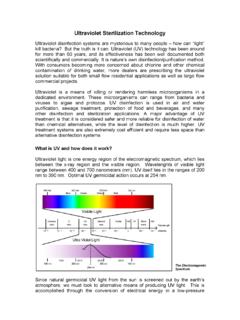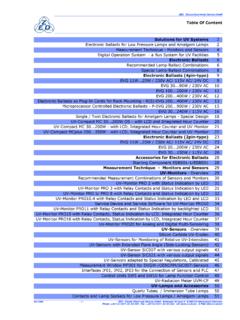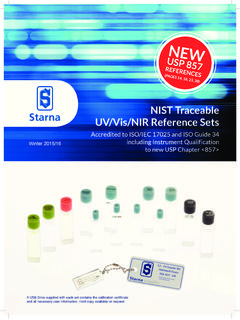Transcription of Basic UV-Vis Theory, Concepts and Applications
1 Basic UV-Vis Theory, Concepts and Applications Page 1 of 28 Introduction Ultraviolet and visible spectrometers have been in general use for the last 35 years and over this period have become the most important analytical instrument in the modern day laboratory. In many Applications other techniques could be employed but none rival UV-Visible spectrometry for its simplicity, versatility, speed, accuracy and cost-effectiveness. This description outlines the Basic principles for those new to UV-Visible spectrometry. It is intended purely as a brief introduction to the technique and it is Thermo Spectronic's policy to continually add to this range of documentation for further details, as they become available. Definitions and Units Radiation is a form of energy and we are constantly reminded of its presence via our sense of sight and ability to feel radiant heat.
2 It may be considered in terms of a wave motion where the wavelength, , is the distance between two successive peaks. The frequency, , is the number of peaks passing a given point per second. These terms are related so that: c = where c is the velocity of light in a vacuum. Figure 1 The wavelength of electromagnetic radiation The full electromagnetic radiation spectrum is continuous and each region merges slowly into the next. For spectroscopy purposes, we choose to characterize light in the ultraviolet and visible regions in terms of wavelength expressed in nanometers. Other units which may be encountered, but whose use is now discouraged, are the Angstrom ( ) and the millimicron (m ). 1nm = 1m = 10 = 10-9 meters Basic UV-Vis Theory, Concepts and Applications Page 2 of 28 For convenience of reference, definitions of the various spectral regions have been set by the Joint Committee on Nomenclature in Applied Spectroscopy: Region Wavelength (nm) Far ultraviolet 10-200 Near ultraviolet 200-380 Visible 380-780 Near infrared 780-3000 Middle infrared 3000-30,000 Far infrared 30,000-300,000 Microwave 300,000-1,000,000,000 The human eye is only sensitive to a tiny proportion of the total electromagnetic spectrum between approximately 380 and 780 nm and within this area we perceive the colors of the rainbow from violet through to red.
3 If the full electromagnetic spectrum shown in Figure 2 was redrawn on a linear scale and the visible region was represented by the length of one centimeter, then the boundary between radio and microwaves would have to be drawn approximately 25 kilometers away! Figure 2 The electromagnetic spectrum Radiation Sources Besides the sun, the most conveniently available source of visible radiation with which we are familiar is the tungsten lamp. If the current in the circuit supplying such a lamp is gradually increased from zero, the lamp filament at first can be felt to be emitting warmth, then glows dull red and the gradually brightens until it is emitting an intense white light and a considerable amount of heat. Basic UV-Vis Theory, Concepts and Applications Page 3 of 28 The radiation from normal hot solids is made up of many wavelengths and the energy emitted at any particular wavelength depends largely on the temperature of the solid and is predictable from probability theory.
4 The curves in Figure 3 show the energy distribution for a tungsten filament at three different temperatures. Such radiation is known as 'black body radiation'. Note how the emitted energy increases with temperature and how the wavelength of maximum energy shifts to shorter wavelengths. More recently it has become common practice to use a variant of this - the tungsten-halogen lamp. The quartz envelope transmits radiation well into the UV region. For the UV region itself the most common source is the deuterium lamp and a UV-Visible spectrometer will usually have both lamp types to cover the entire wavelength range. Figure 3 Tungsten filament radiation Quantum Theory To gain an understanding of the origins of practical absorption spectrometry, a short diversion into quantum theory is necessary.
5 For this purpose, it is best to think of radiation as a stream of particles known as photons instead of the waves considered earlier. Atoms and molecules exist in a number of defined energy states or levels and a change of level requires the absorption or emission of an integral number of a unit of energy called a quantum, or in our context, a photon. The energy of a photon absorbed or emitted during a transition from one molecular energy level to another is given by the equation e=h where h is known as Planck's constant and is the frequency of the photon. We have already seen that c= , therefore, E= hc/ Basic UV-Vis Theory, Concepts and Applications Page 4 of 28 Thus, the shorter the wavelength, the greater the energy of the photon and vice versa.
6 A molecule of any substance has an internal energy which can be considered as the sum of the energy of its electrons, the energy of vibration between its constituent atoms and the energy associated with rotation of the molecule. The electronic energy levels of simple molecules are widely separated and usually only the absorption of a high energy photon, that is one of very short wavelength, can excite a molecule from one level to another. Figure 4 Energy levels of a molecule In complex molecules the energy levels are more closely spaced and photons of near ultraviolet and visible light can effect the transition. These substances, therefore, will absorb light in some areas of the near ultraviolet and visible regions. The vibrational energy states of the various parts of a molecule are much closer together than the electronic energy levels and thus protons of lower energy (longer wavelength) are sufficient to bring about vibrational changes.
7 light absorption due to only to vibrational changes occurs in the infrared region. The rotational energy states of molecules are so closely spaced that light in the far infrared and microwave regions of the electromagnetic spectrum has enough energy to cause these small changes. Basic UV-Vis Theory, Concepts and Applications Page 5 of 28 Figure 5 Idealized absorption spectrum For ultraviolet and visible wavelengths, one should expect from this discussion that the absorption spectrum of a molecule ( , a plot of its degree of absorption against the wavelength of the incident radiation) should show a few very sharp lines. Each line should occur at a wavelength where the energy of an incident photon exactly matches the energy required to excite an electronic transition.
8 In practice it is found that the ultraviolet and visible spectrum of most molecules consists of a few humps rather than sharp lines. These humps show than the molecule is absorbing radiation over a band of wavelengths. One reason for this band, rather than line absorption is that an electronic level transition is usually accompanied by a simultaneous change between the more numerous vibrational levels. Thus, a photon with a little too much or too little energy to be accepted by the molecule for a 'pure' electronic transition can be utilized for a transition between one of the vibrational levels associated with the lower electronic state to one of the vibrational levels of a higher electronic state. If the difference in electronic energy is 'E' and the difference in vibrational energy is 'e', then photons with energies of E, E+e, E+2e, E-e, E-2e, etc.
9 Will be absorbed. Furthermore, each of the many vibrational levels associated with the electronic states also has a large number of rotational levels associated with it. Thus a transition can consist of a large electronic component, a smaller vibrational element and an even smaller rotational change. The rotational contribution to the transition has the effect of filling in the gaps in the vibrational fine structure. In addition, when molecules are closely packed together as they normally are in solution, they exert influences on each other which slightly disturb the already numerous, and almost infinite energy levels and blur the sharp spectral lines into bands. These effects can be seen in the spectra of benzene as a vapor and in solution.
10 In the vapor, the transitions between the vibration levels are visible as bands superimposed on the main electronic transition bands. In solution they merge together and at high temperature or pressure even the electronic bands can blur to produce single wide band such as that enclosed by the dotted line in Figure 6. Basic UV-Vis Theory, Concepts and Applications Page 6 of 28 Figure 6 Vapor and solution spectra of Benzene General Chemical Origins When white light falls upon a sample, the light may be totally reflected, in which case the substance appears white or the light may be totally absorbed, in which case the substance will appear black. If, however, only a portion of the light is absorbed and the balance is reflected, the color of the sample is determined by the reflected light .








